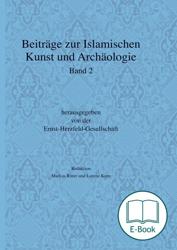The subjects of volume 2 of the „Beiträge zur Islamischen Kunst und Archäologie“ (BIKA, Contributions to Islamic Art History and Archaeology) include architecture, painting, textile arts, minor and applied arts as well as archaeology. Analyses of individual works and groups side with synthesizing contributions. In terms of geography, the volume reaches from Spain to Iran and India, and back to Europe; in chronology, from the Early Islamic period to the 20th century. Each contribution starts with an English abstract. 160 figures in color and black & white – most of them published for the first time – illustrate the volume.
Volume 2 of the „Beiträge zur Islamischen Kunst und Archäologie“ (BIKA, Contributions to Islamic Art History and Archaeology), published by the Ernst Herzfeld Society, presents contributions from the European colloquies in Vienna in 2007 and in Bamberg in 2008, which were organised on behalf of the Society. Subjects include architecture and archaeology as well as painting, textile arts, minor and applied arts. They cover the lands from Spain to Iran and India, and back to Europe; in chronology, they range from the Early Islamic period to the 20th century. Following the title of the Vienna colloquy, aspects of representation are a red herring in several contributions; in others, trade and reception in or from Europe. Each contributions starts with an English abstract. 160 figures, partly in color and most of them published for the first time, turn the volume into a sumptuously illustrated book. The editors are Markus Ritter (University of Zurich) and Lorenz Korn (University of Bamberg).
The contributions cover three greater regions and periods, starting with research on the 8th-13th centuries in Islamic Spain. Antonio Pena (Barcelona) places the re-use of ancient „spolia“ in the context of caliphal representation [Spolia Serving Power: The Testimony of the Great Mosque of Córdoba]. Magdalena Valor (Sevilla) sketches the urban building history of the Almohad centre [Sevilla, Capital of the Almohads in al-Andalus]. Tobias Rütenik (Berlin) demonstrates how to deduce re-used Islamic sacred buildings from Christian ones [Transformations of Mosques to Churches at Toledo From the Perspective of Building Archaeology]. Klaus Graf (Saarbrücken) presents a typology of pottery from archaeological finds [The Islamic Pottery of Cuncos, Estremadura].
Iran and Central Asia in the 12th to 15th centuries form a second focus. Lorenz Korn (Bamberg) introduces a scarcely-known domed mosque datable to the post-Seljuq period in Eastern Iran [The Masjid-i Gunbad at Sangan-i Pa’in (Khurasan/Iran): Architecture, Decoration, and Inscriptions]. Markus Ritter (Zurich) discusses, based on new reasearch, a unique textile with Arab inscriptions [Art With a Message: The cloth of Silk and Gold for the Ilkhan Abu Sa’id of Iran (Burial Garment of Rudolph IV in Vienna) - Reconstruction, Type, Medium of Representation]. Márta Járó (Budapest) examines a technical aspect in the cloth [Late Medieval Technology of Craft: The Metal Thread in the Vienna Cloth for Abu Sa’id]. Yuka Kadoi (Chicago) poses for the Timurid period the question of flags in pre-modern Islamic states (On the Timurid Flag).
Art for Europe and Islamic art in Europe constitute the third part, covering the 15th to 20th centuries. Barbara Karl (Vienna) looks into luxury objects from India as products for trade (Art for the International Market: Three Mother-of-Pearl Objects from Sixteenth-Century Gujarat in Early Modern European Collections). Iván Szántó (Budapest) raises attention to Eastern European parallels of Europeanizing Safavid painting in Iran (Monumental Art East of the Baroque) and to the reception of Arab forms in Hungary (Mamluk Influences in Hungarian Art). Martin Gussone (Berlin) analyzes and interprets the eclecticism of a German mosque from 1915 [The Mosque in the Half-Moon-Camp at Wünsdorf Between Jihad Propganda and Orientalism].
Aus dem Inhalt:
A. Peña: Spolien im Dienste der Macht: Das Zeugnis der Großen Moschee von Córdoba - M. Valor Piechotta: Sevilla, Hauptstadt der Almohaden in al-Andalus - T. Rütenik: Transformation von Moscheen zu Kirchen in Toledo - K. Graf: Die islamische Keramik der Wüstung Cuncos (Extremadura, Spanien) - L. Korn: Der Masğid-i Gunbad in Sangān-i Pāīn (Hurāsān/Iran): Architektur, Baudekor und Inschriften - M. Ritter: Der goldene islamische Herrscher. Der Gold-Seide-Stoff mit Inschriften für den Mongolen Abū Saīd von Iran - Y. Kadoi: On the Timurid Flag - I. Szántó: Monumental Art East of the Baroque
„Die unterschiedlichen Beiträge des neuen Bandes geben einen guten Überblick über die Vielfalt der Themen in der aktuellen wissenschaftlichen Auseinandersetzung auf dem Gebiet der islamischen Kunst und Archäologie. Besonders begrüßenswert ist der schnelle Erscheinungszeitpunkt, so dass eine wünschenswerte Aktualität gewährleistet bleibt. Es ist zu hoffen, dass diese Zeitschrift den erreichten Qualitätsstand beibehalten kann und auch weiterhin ein Sprachrohr für etablierte Wissenschaftler, vor allem aber ein Forum für den wissenschaftlichen Nachwuchs darstellen wird.“
Jens Kröger
In: sehepunkte
http://www.sehepunkte.de/2010/11/18635.html(22. November 2010)
Markus Ritter is Assistant Professor for the History of Islamic Art at the University of Zurich in Switzerland. He studied in Bamberg, Cairo and Teheran, and received his PhD in 2003 from the University of Bamberg. He taught at different universities and was a researcher in the Institute of Iranian Studies of the Austrian Academy of Sciences in Vienna. His areas of research include the arts and architecture in Iran and in Early Islamic Palestine.
Lorenz Korn is Professor for Islamic Art History at the University of Bamberg. He studied in Tübingen and Oxford, received his PhD in 1999 from the University of Tübingen and was Aga Khan postdoctoral fellow at Harvard in 1999-2000. His areas of research include architecture and architectural decoration in the central Islamic lands (10th-16th century), Iranian metalwork, and epigraphy.
The aim of the Ernst Herzfeld Society is an adequate edition of all papers presented at the colloquia and other articles of academic value.


 Table of Contents
Table of Contents